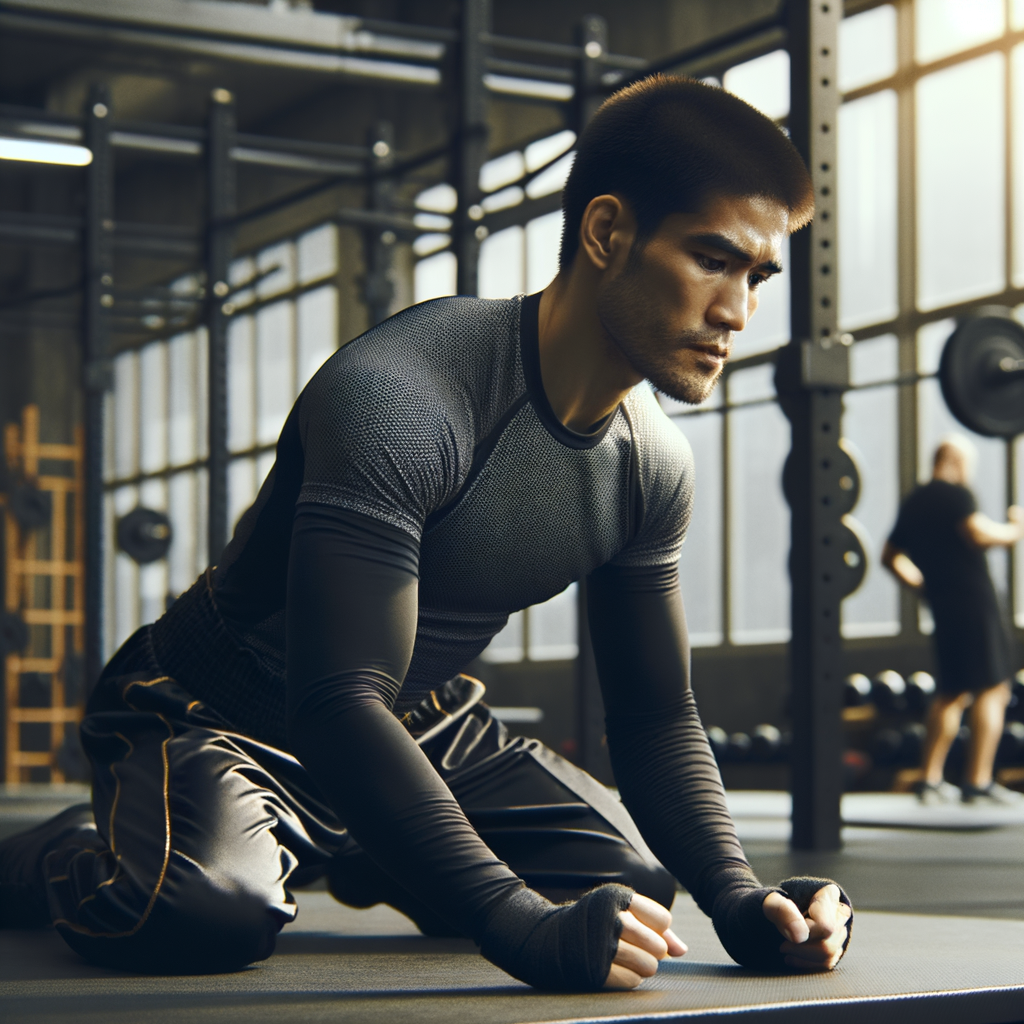
Introduction to Bodyweight Strength Training for Boxers
Welcome to our comprehensive guide on bodyweight strength training for boxers. This introductory section will help you understand the importance of strength training in boxing and the benefits of bodyweight exercises for building strength.
- Understanding the Importance of Strength Training for Boxers
- Benefits of Bodyweight Exercises for Strength Building
Strength training is a critical component of a boxer’s fitness regimen. It’s not just about having the power to throw a punch; it’s about endurance, speed, agility, and resilience. Boxers need to be able to withstand blows, maintain their balance, and keep moving with agility and speed. Strength training helps develop these attributes.
Moreover, strength training can help reduce the risk of injury. By strengthening muscles, tendons, and ligaments, boxers can better protect their bodies from the impacts and strains of the sport. In fact, a study by the American College of Sports Medicine found that regular strength training can reduce the risk of sports injuries by up to 50%.
Bodyweight exercises offer a host of benefits for strength building. They are versatile, requiring no equipment, and can be done anywhere, making them a practical choice for boxers.
These exercises engage multiple muscle groups at once, promoting functional strength and improving overall athleticism. They also enhance balance, coordination, and flexibility – all essential skills for a boxer.
Furthermore, bodyweight exercises allow for a high degree of customization. Boxers can adjust the intensity and complexity of the exercises to match their fitness levels and goals. This makes bodyweight training suitable for both beginners and seasoned athletes.
In the following sections, we will delve deeper into specific bodyweight exercises for boxers, provide workout routines, and share success stories of boxers who have excelled with bodyweight training. Stay tuned!
A Boxer’s Guide to Strength: Bodyweight Exercises
As a boxer, strength is a crucial aspect of your training. It’s not just about having powerful punches; it’s also about endurance, speed, and agility. One way to build strength is through bodyweight exercises. These exercises use your own body weight as resistance, making them a practical and efficient way to train. Let’s explore some upper body exercises that can help you build strength.
Upper Body Exercises
Upper body strength is vital for a boxer. It helps you deliver powerful punches and maintain your guard. Here are some bodyweight exercises that can help you build upper body strength:
- Push-ups: Push-ups are a versatile exercise that can help you build overall upper body strength. They work multiple muscle groups, including your chest, shoulders, and triceps. To do a push-up, start in a high plank position. Lower your body until your chest almost touches the floor, then push yourself back up. Aim for three sets of 10-15 repetitions.
- Pull-ups: Pull-ups are great for building strength in your back and biceps. They require a pull-up bar, but you can also use a tree branch or a sturdy beam. To do a pull-up, grab the bar with your palms facing away from you. Pull yourself up until your chin is above the bar, then lower yourself back down. Aim for three sets of 5-10 repetitions.
- Dips: Dips target the chest and triceps. You can do them using parallel bars or the edge of a bench or chair. To do a dip, hold onto the bars or edge of the bench and lower your body until your elbows are at a 90-degree angle. Then push yourself back up. Aim for three sets of 10-15 repetitions.
Remember, consistency is key when it comes to strength training. Make sure to include these exercises in your regular workout routine, and gradually increase the number of repetitions as you get stronger. Always maintain proper form to avoid injuries and get the most out of each exercise.
Next, we’ll explore some lower body and core exercises that can further enhance your strength as a boxer. Stay tuned!
Lower Body Exercises
As a boxer, it’s crucial to have a strong lower body. Not only does it provide the power for your punches, but it also keeps you grounded and balanced during a fight. Here are three fundamental lower body exercises that can help enhance your strength and power.
-
Squats: A fundamental exercise for leg strength
Squats are a basic yet powerful exercise that targets your quadriceps, hamstrings, and glutes. They are essential for improving leg strength and power. To perform a squat, stand with your feet shoulder-width apart, bend your knees and lower your body as if you were sitting in a chair. Make sure to keep your back straight and your knees over your toes. Then, push back up to the starting position. Aim for three sets of 10-15 repetitions.
-
Lunges: Enhancing balance and lower body power
Lunges are another excellent exercise for the lower body. They target the same muscles as squats but also help improve balance and coordination. To perform a lunge, step forward with one foot and lower your body until your front knee is at a 90-degree angle. Push back up and repeat with the other leg. Aim for three sets of 10-15 repetitions per leg.
-
Pistol Squats: An advanced exercise for unilateral strength
Pistol squats are a more advanced exercise that can help improve unilateral strength – that’s the strength in each leg individually. This can be particularly beneficial for boxers as it can help improve balance and power in each leg. To perform a pistol squat, stand on one leg, extend the other leg in front of you, and then lower your body as far as you can. Push back up and repeat with the other leg. Aim for three sets of 5-10 repetitions per leg.
Remember, consistency is key when it comes to strength training. Aim to incorporate these exercises into your routine at least two to three times a week for the best results.
Core Exercises
Now that we’ve covered upper and lower body exercises, let’s focus on the core. The core muscles are crucial for boxers as they provide stability, power, and endurance. Here are three key bodyweight exercises to build a strong and stable core.
-
Planks: Building a strong and stable core
Planks are a simple yet effective exercise for strengthening your core. They work your entire core, not just your abs, and help improve stability and posture. To perform a plank, get into a push-up position, but rest your weight on your forearms instead of your hands. Keep your body straight and hold this position for as long as you can.
Pro Tip: Try to hold the plank for longer periods each time you exercise. This will gradually build your core strength.
-
Leg Raises: Targeting the lower abs
Leg raises are a great exercise for targeting the lower abs, a muscle group that can be hard to reach with other exercises. To do a leg raise, lie flat on your back, then slowly raise your legs until they’re perpendicular to the floor. Lower them back down without letting them touch the floor and repeat.
Pro Tip: For an extra challenge, try holding a medicine ball between your feet as you perform the exercise.
-
Russian Twists: A rotational exercise for oblique strength
Russian twists are a rotational exercise that targets the obliques, the muscles on the sides of your abdomen. These muscles are crucial for boxers as they aid in the rotation of the torso, a key movement in delivering powerful punches. To do a Russian twist, sit on the floor with your knees bent, pull your abs to your spine, and lean back a few inches while keeping your back straight. Hold your hands at your chest, and twist your torso to the right, then to the left to complete one rep.
Pro Tip: For an added challenge, try holding a weight in your hands as you twist.
Remember, consistency is key in strength training. Incorporate these exercises into your regular workout routine to see improvements in your core strength and boxing performance.
Strength Training Workouts for Boxers
Strength training is a crucial part of a boxer’s routine. It helps improve power, speed, and endurance, all of which are vital in the ring. As a beginner, it’s important to start with basic exercises and gradually introduce more challenging ones. Here are two beginner workouts to get you started.
Beginner Workouts
-
Workout 1: Focusing on Fundamental Movements
This workout aims to build a strong foundation. It includes exercises that target the major muscle groups used in boxing. Here’s a simple routine:
- Push-ups: 3 sets of 10 repetitions
- Squats: 3 sets of 10 repetitions
- Planks: 3 sets of 30 seconds
These exercises will help improve your upper body strength, lower body power, and core stability, which are essential for boxing.
-
Workout 2: Introducing More Challenging Exercises
Once you’re comfortable with the basics, it’s time to introduce more challenging exercises. This workout includes exercises that require more coordination and strength. Here’s a sample routine:
- Jumping jacks: 3 sets of 15 repetitions
- Mountain climbers: 3 sets of 15 repetitions
- Burpees: 3 sets of 10 repetitions
These exercises will help improve your cardiovascular fitness, agility, and explosive power, which are important for boxing.
Remember, consistency is key in strength training. Stick to your routine, and you’ll see improvements over time. As you get stronger, don’t be afraid to challenge yourself with more advanced workouts.
Intermediate Workouts
As you progress in your strength training journey, it’s time to step up the game and challenge yourself with intermediate workouts. These workouts are designed to help you build more strength and endurance, crucial for a boxer’s performance in the ring.
-
Workout 1: Increasing Intensity and Volume
Once you’ve mastered the basic exercises, it’s time to increase the intensity and volume of your workouts. This means doing more repetitions and sets of each exercise, and possibly adding more challenging variations. For example, if you’ve been doing regular push-ups, try doing them with your feet elevated or add a clap in between each push-up.
Remember, the goal is not to exhaust yourself, but to gradually increase your strength and endurance. Always listen to your body and take breaks when needed.
-
Workout 2: Incorporating Advanced Exercises
As an intermediate boxer, you should start incorporating advanced exercises into your routine. These exercises often involve more complex movements and require a higher level of strength and coordination. Examples include pistol squats, handstand push-ups, and one-arm pull-ups.
These exercises not only help you build strength, but also improve your balance, agility, and body control, all of which are essential for boxing.
Remember, the key to successful strength training is consistency and gradual progression. Don’t rush into advanced workouts if you’re not ready. Take your time to master each exercise and always prioritize form over quantity. With patience and dedication, you’ll see significant improvements in your strength and boxing performance.
| Workout | Key Focus | Examples |
|---|---|---|
| Workout 1: Increasing Intensity and Volume | More repetitions and sets, challenging variations | Elevated push-ups, clap push-ups |
| Workout 2: Incorporating Advanced Exercises | Complex movements, higher strength and coordination | Pistol squats, handstand push-ups, one-arm pull-ups |
Advanced Workouts
As you progress in your bodyweight strength training journey, you will need to challenge your body further to continue seeing improvements. This is where advanced workouts come into play. These workouts are designed to push your limits and help you reach your peak strength. Let’s dive into two advanced workouts that are perfect for boxers looking to take their strength to the next level.
- Workout 1: High Intensity, High Volume Workouts for Peak Strength
- Workout 2: Focusing on Unilateral Exercises and Core Strength
This workout is all about pushing your body to its limits. It involves performing a high number of repetitions at a high intensity. This type of training is excellent for building muscle endurance and peak strength. For example, you might perform push-ups, pull-ups, and squats for a set number of repetitions, then repeat the cycle several times. Remember, the goal here is to challenge your body, so don’t be afraid to push yourself.
Unilateral exercises are movements that are performed on one side of the body at a time. These exercises are great for improving balance, coordination, and core strength – all essential for boxers. Examples of unilateral exercises include single-leg squats and one-arm push-ups. In addition to these, you should also incorporate core exercises like planks and Russian twists to strengthen your midsection, which is crucial for delivering powerful punches.
Remember, these workouts are advanced and should only be attempted once you have a solid foundation of strength and are comfortable with intermediate exercises. Always listen to your body and rest as needed. With consistency and hard work, you’ll see significant improvements in your strength and boxing performance.
| Workout | Focus | Examples |
|---|---|---|
| High Intensity, High Volume | Endurance, Peak Strength | Push-ups, Pull-ups, Squats |
| Unilateral and Core Strength | Balance, Coordination, Core Strength | Single-leg Squats, One-arm Push-ups, Planks |
As the great Muhammad Ali once said, “The fight is won or lost far away from witnesses – behind the lines, in the gym, and out there on the road, long before I dance under those lights.” So, keep pushing your limits, and you’ll be dancing under those lights in no time.
Building Strength Without Weights: A Boxer’s Bodyweight Strength Guide
As a boxer, you may think that lifting weights is the only way to build strength. However, this is not the case. You can build significant strength using just your bodyweight. This guide will help you understand how to do this effectively.
- Understanding the principles of progressive overload
Progressive overload is a key principle in strength training. It means gradually increasing the amount of stress you put on your body during exercise. This can be done by increasing the number of repetitions, the intensity of the exercise, or the duration of the workout. For example, if you start with 10 push-ups a day, you can increase this to 15, then 20, and so on. This gradual increase helps your muscles adapt and grow stronger over time.
- How to increase difficulty without adding weights
There are several ways to increase the difficulty of your workouts without adding weights. One way is to change the tempo of your exercises. For example, you can perform push-ups more slowly to increase the time your muscles are under tension. Another way is to change the angle of your exercises. For example, you can do push-ups with your feet elevated to make them more challenging. You can also add more complex movements to your routine, like burpees or jump squats, to increase the difficulty.
- Importance of rest and recovery in strength building
Rest and recovery are just as important as the workouts themselves in building strength. When you exercise, you create tiny tears in your muscles. It’s during rest that your body repairs these tears, making your muscles stronger. That’s why it’s important to take rest days and get enough sleep. It’s also important to eat a balanced diet to provide your body with the nutrients it needs to repair and build muscle.
In conclusion, building strength without weights is not only possible but can be very effective. By understanding the principles of progressive overload, knowing how to increase the difficulty of your workouts, and prioritizing rest and recovery, you can build significant strength using just your bodyweight.
Case Studies: Boxers Who Excelled with Bodyweight Training
Let’s take a look at two inspiring stories of boxers who have achieved great success through bodyweight training. These case studies will show you the power of bodyweight exercises in boxing.
-
Case Study 1: A beginner boxer’s journey to strength
Meet John, a beginner boxer who had never stepped into a gym before he decided to take up boxing. He started with basic bodyweight exercises like push-ups, squats, and lunges. With consistent training, he noticed significant improvements in his strength and endurance. His punching power increased, and he could last longer in the ring.
John’s success is a testament to the effectiveness of bodyweight training. He didn’t need fancy gym equipment to build his strength. All he needed was determination, consistency, and the right bodyweight exercises.
-
Case Study 2: An experienced boxer’s shift to bodyweight training
Next, let’s talk about Sarah, an experienced boxer who had been relying on weightlifting for strength training. However, she felt that her progress had plateaued. That’s when she decided to switch to bodyweight training.
She incorporated exercises like pull-ups, dips, and plyometric push-ups into her routine. The results were astounding. She became more agile, her punches became faster, and she could move around the ring more fluidly. Sarah’s story shows that even experienced boxers can benefit from bodyweight training.
In conclusion, both beginner and experienced boxers can excel with bodyweight training. It’s all about choosing the right exercises and being consistent with your training. Remember, strength is not just about lifting heavy weights. It’s about using your body effectively to deliver powerful punches and move around the ring with ease.
Key Takeaways: Bodyweight Strength Workouts for Boxers
As we wrap up our discussion on bodyweight strength workouts for boxers, let’s summarize the key points we’ve covered. These takeaways will help you understand the importance of these workouts and how you can incorporate them into your training regimen.
- Importance of consistency and progressive overload:
- The role of nutrition in strength building:
- Understanding your body and listening to its signals:
Consistency is key in any training regimen. Regularly performing bodyweight exercises can help build strength over time. Moreover, progressive overload, which involves gradually increasing the intensity of your workouts, is crucial for continuous improvement. This could mean increasing the number of repetitions or sets, or trying more challenging exercises.
Nutrition plays a significant role in strength building. Consuming a balanced diet rich in proteins, carbohydrates, and healthy fats can help fuel your workouts and aid in muscle recovery and growth. Remember, your body needs the right nutrients to build and repair muscles.
Lastly, it’s essential to understand your body and listen to its signals. If you feel pain or discomfort during a workout, it might be a sign that you’re pushing yourself too hard or performing an exercise incorrectly. Rest and recovery are just as important as the workouts themselves. Always remember, your health and safety should be your top priority.
In conclusion, bodyweight strength workouts can be a valuable addition to a boxer’s training regimen. They offer a convenient and effective way to build strength, improve endurance, and enhance overall performance. However, it’s important to approach them with consistency, proper nutrition, and an understanding of your body’s needs and limits.






